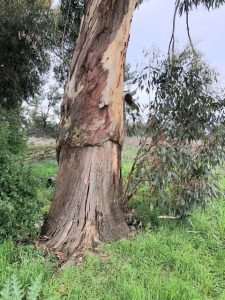When Aboriginal people come to visit we rarely discuss politics but now the personal has become political when it comes to skin colour. I don’t know when Australia will achieve total colour-blindness but for the last 2 centuries you had certain advantages in life if your skin tone was closer to Anglo white. Now Yolngu black is the new shade for ‘authentic advocates’ in the media apparently and there is bias against people with mixed heritage. Senator Jacinta Nampijinpa Price calls herself a Walpiri/ Celtic but she is one of the very few Indigenous politicians who openly acknowledges their european genetics. Her maiden speech in parliament quoted Martin Luther King “I look to a day when people will not be judged not by the colour of their skin, but by the content of their character” Go girl – JP 4 PM
The eagerly awaited primary school visit has come & gone last month & was a great success according to those involved. Allan Tighe met the school buses and took them out to various sites along the paleochannel in Telinebone (Murrumanaarr aka Moramana). They went to the wells & the wedding arch & had fun fishing for yabbies in the bore drain & picking bumble fruit.
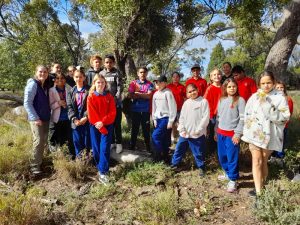
I was mustering sheep that day unfortunately but really, its better the mostly Aboriginal staff & students do own thing. They don’t need ‘bossy white women’ telling them about their own culture they just need access to their historical camps/ songlines/ trees. Who knows maybe some of those kids will grow up to work in their own local Aboriginal tourism enterprises?
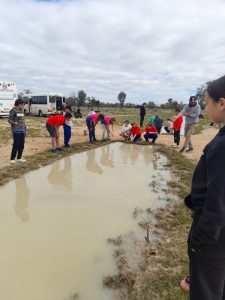
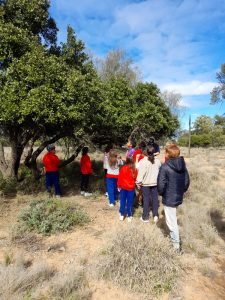
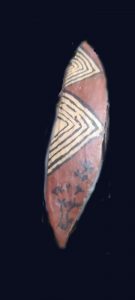 This shield was made by Archie, a young Dunghutti Gamilaroi boy in year 1 at St John the Evangelist Catholic Parish Primary School, Campbelltown. My friend Andrew Oldfield is an AEA (Aboriginal Education Assistant) there and helped Archie & his mate Owen remove the bark & prepare the shield in the traditional manner. They used a stone axe, ochre/ charcoal & also traditional glue for the handles. You can see the Murrawa fidgety lizard on the bottom of the shield which is Archie’s totem.
This shield was made by Archie, a young Dunghutti Gamilaroi boy in year 1 at St John the Evangelist Catholic Parish Primary School, Campbelltown. My friend Andrew Oldfield is an AEA (Aboriginal Education Assistant) there and helped Archie & his mate Owen remove the bark & prepare the shield in the traditional manner. They used a stone axe, ochre/ charcoal & also traditional glue for the handles. You can see the Murrawa fidgety lizard on the bottom of the shield which is Archie’s totem.
Other visitors last month were Priscilla Reid & Rhonda Ashby who are always thought-provoking yet fun to hang out with. Priscilla also brought her mum Patti & we had a great day all round – again in Telinebone paddock. If you’ve never spent time in the bush (or ‘out on country’ as its known now) with older Aboriginal women you have missed out. They gather this & that – touching, smelling, smiling. They discuss this & that and laugh at nearly everything. Rebukes for whitefella impatience are kind and the hours flow like the Barwon Darling river – drifting forward then looping back. I wish they would come more often these women but they are busy with their own lives. When we break conversational bread, the crumbs settle in my subconscious. Like modern sourdough, maybe the ancient guli (native millet), ganalay (mitchell grass) & garaarr (kangaroo grass) breads of knowledge also needed a live fermenting culture?
Russell Fairfax, partner of Jen Silcock, has another wormhole into my brain. He & Jen are my only links to academia now. I have a dim view of academics in general because they are conspicuously absent when it comes to the TinTs. – I need funding for a ‘where the bloody hell are you?’ tourism campaign for boffins perhaps? Ecologists Russell & Jen are the exception to this quote from David Hunt’s Girt Nation Vol 3 – “Academics are, as a rule, bitter & twisted people who cope poorly when people without doctorates write best sellers on their subject of expertise ..” Does that sound a bit “Dark Emu” to you or what? I will quote Russell again as to why primary schools ‘get it’ & universities don’t – “Because it’s easier to teach under ACARA (The Australian Curriculum, Assessment and Reporting Authority) cross-curriculum priorities than in higher academia. Its easier to conceive transmission of knowledge to primary school-age could have snuck through over a couple of centuries and escaped higher academia’s attention for a couple of centuries. Thanks to long-lived trees.”
Ive also had email conversations lately with Kim Grace & I will copy / paste this as Im a little pressed for time:
Hi, My brother has a farm near a town called Quandialla on the Bland Plain in central NSW on Wiradjuri country. I am having trouble convincing him and others that what I am finding are man made scar trees. It is frustrating. Do you know if and why scars would be so high on trees as in the image attached? I believe what I have found are Aboriginal scars, but no one here seems to think so.
Best wishes Kim Grace
pS i would say there are at least 40 here
Hi Kim – its great to hear from you & good to know other people are out looking for CMTs (Culturally Modified Trees) or scarred trees. I often use the CMT label because many old trees around here have man made “rings”, have other trees planted in them (TinTs) or are bent, twisted (manipulated) – but have no visible scars. My eucalypts are different varieties to those around Quandialla and would be much slower growing because we have less rain. So its hard for me to say for sure if these trees in your photos have cultural scars or scars by other causes – branch drop, birds, lightning/ bush fire, goats/ rabbits etc. See Scar Trees | ringbarking & non indigenous
If there are lots of cultural scars in one area then this place was probably an old campsite. Campsites always have reliable water nearby, good shelter trees and sandy hollows. There are usually campfire scars on the bases of leaning trees where they have protected the ashes from the weather & the remains of cooking sites/ovens. There would be medicinal trees/ bushes/ plants scattered around & possibly stone artefacts or tool making chips.
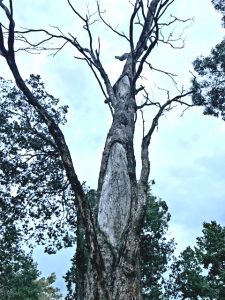
The main indicator of cultural scars is depth & the size of the epicormic shoots. Man made scars high up in trees are rare and almost always symbolic. If you wanted some bark for shelter you would cut it from the base of the tree. It would be very difficult to remove a slab of bark like that on your pic above while hanging on for dear life. Yes the scar could have grown up with the tree but they shrink over time as the scar heals so high scars are unusual on live trees. Those 2 small branches growing near the bottom of the scar are ‘reshoots’ or ‘epicormic shoots’ and are a reaction to the scar. These reshoots are small & the scar is shallow so in my opinion this scar has been caused by gulahs or other bark strippers such as cockatoos
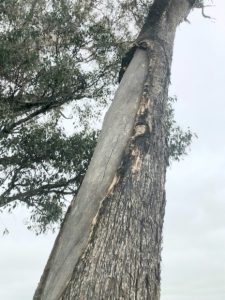
This scar above has a better shape but again is quite shallow. Cultural scars are usually oval & are quite symmetrical. To make a coolamon the people often selected a concave or convex bend in the trunk. If you removed the outer layer (bark & cambium) from a bend or elbow in the trunk you have a prototype dish & don’t have to spend as much time shaping & manipulating it over a fire. Flatter coolamons were also useful for carrying other things but if you were transporting water you would need a bowl shape.
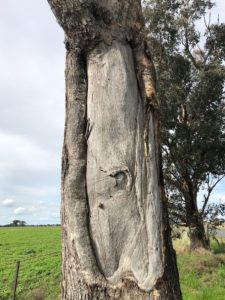
I would say the scar above is man-made but the man was the farmer or contractor building the adjacent fence or bitumen road. Scars near roads or fences are always dodgy as they are mostly caused by impacts with machinery. When farmers are fencing they usually clear the fence line with a bulldozer or chainsaw to remove trees. This tree looks like it has been hit with something or had a branch ripped off. Cultural scars have smooth faces except for rare axe marks on the top or bottom. If the axe marks are thru the centre its probably ringbarking.
This last scar tree looks like a redgum? Redgum scars heal over quickly compared to coolabah ones but bimblebox tree scars last longer than any other eucalypt Ive seen. Scars generally heal faster along the sides than the top & bottom so many look like they were cut for shields. However when you think about it logically – how many shields would a man need? Usually 1 for fighting & 1 for ceremonial occasions. Most scars are for shelter or tools or coolamons and this one below is none of those. Again the tree has reshot at the bottom & quite recently. This scar could be the result of a grass fire or caused by bark chewing rabbits? If it was a fire scar you should be able to see some charcoal still. There are scars here caused by livestock rubbing on trees – usually in small holding paddocks or feedlots. Merino sheep rub on trees a lot when they have lice for example. That’s about all I can tell you atm but keep looking & stay curious. Have you been to Yuranigh’s grave at Molong? All but the dead carved tree have grown over in the last 170 years or so. Scars are wounds & wounds heal.
If you thought you could read a blog of mine with only scant references to TinTs – you thought wrong. The camp in Stud paddock swamp is very interesting in a few ways. Firstly there is a huge central coolabah tree & european well that only fails in the driest of droughts. Secondly there are 10 TinTs around the swamp periphery of which 7 are peach bush in box. Of these 7 peach bush TinTs most are planted high up & have seeded peach bush clusters underneath. This camp has been grown rather than constructed with the guests acting as living multiplying architecture.
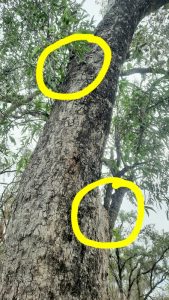
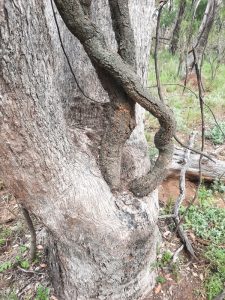
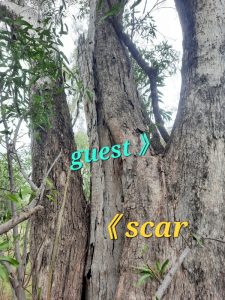
100 meters away there are a few old bent down coolabahs that form your more traditional camp. The people would have to ‘bark-up’ these shelters in wet weather with considerable effort. Also the mosquitos would be fierce and the ground cold &wet.
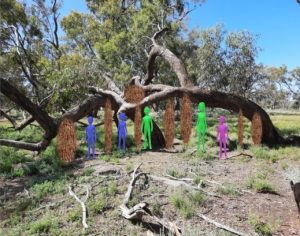
I think they ‘grew’ the peach bush camp on higher sandy land as an alternative shelter. I also think peach bush leaves were burnt to keep the mozzies away. Bimble box/ Peach bush camps with sedge/ dichondra carpets were all the rage here. You should come up & see them sometime if you are not too bitter & twisted?

